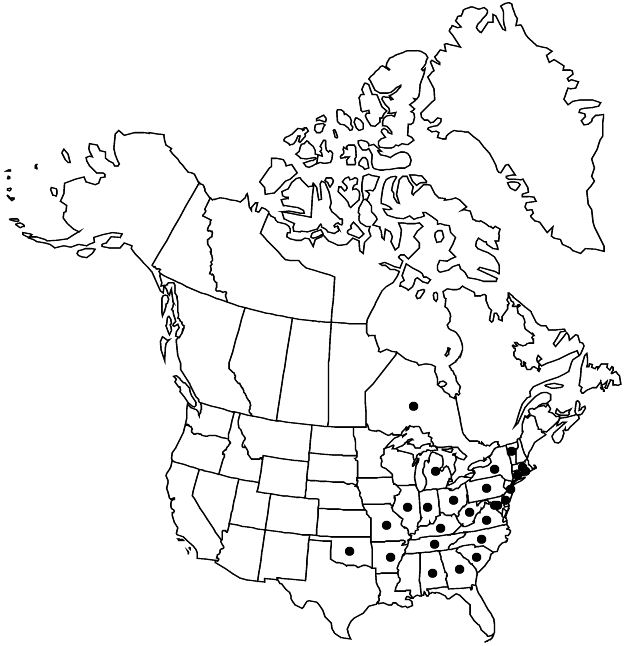Geum virginianum
Sp. Pl. 1: 500. 1753.
Plants leafy-stemmed. Stems 25–110 cm, puberulent and hirsute to densely hirsute, some hairs 2–2.5 mm. Leaves: basal 12–25 cm, blade simple or pinnate, major leaflets 3–5, plus 0–4 minor basal ones, terminal leaflet slightly larger than major laterals; cauline 4–15 (–23) cm, stipules ± free, 11–48 × 6–35 mm, blade 3-foliolate or simple and 3-lobed to unlobed. Inflorescences 3–14-flowered. Pedicels puberulent, sometimes with scattered hairs, eglandular. Flowers erect; epicalyx bractlets 1–1.5 mm; hypanthium green; sepals spreading but soon reflexed, 3–6 mm; petals spreading, cream, oblong to elliptic, (1.5–) 2–3.5 mm, shorter than sepals, apex rounded. Fruiting tori sessile, densely bristly, hairs 1–2.3 mm. Fruiting styles geniculate-jointed, proximal segment persistent, (3–) 4.5–7 mm, apex hooked, glabrate, distal segment deciduous, 1–2 mm, pilose in basal 1/2, hairs much longer than diam. of style.
Phenology: Flowering summer.
Habitat: Mostly forests, river bottoms to dry uplands, rocky slopes, oak-hickory woods
Elevation: 0–700 m
Distribution

Ont., Ala., Ark., Conn., Del., D.C., Ga., Ill., Ind., Ky., Md., Mass., Mich., Mo., N.J., N.Y., N.C., Ohio, Okla., Pa., R.I., S.C., Tenn., Vt., Va., W.Va.
Discussion
Geum virginianum has been confused nomenclaturally with G. laciniatum. B. L. Robinson and M. L. Fernald (1908) and J. K. Small (1933) misapplied the name G. virginianum to the species correctly named G. laciniatum, and they used the names G. flavum (Robinson and Fernald) and G. hirsutum (Small) for what is correctly named G. virginianum. Much of what is named G. virginianum in older herbarium collections is actually G. laciniatum.
In habit and leaf form, Geum virginianum is similar to G. canadense. Geum virginianum differs in having cream petals shorter than the sepals (versus white and usually equal to or longer), the largest stipules of the cauline leaves 20–48 × 10–35 mm (versus smaller), and the stems hirsute to densely hirsute (versus glabrate to downy with only scattered longer hairs). The variability within G. canadense is so great that for some specimens it is difficult to determine whether they belong to G. canadense or G. virginianum.
L. A. Raynor (1952) believed Geum virginianum to be an F1 hybrid between G. aleppicum and G. canadense. K. R. Robertson (1974) acknowledged that some herbarium specimens assignable to G. virginianum from the area where G. aleppicum and G. canadense are sympatric have mostly aborted pollen and may represent natural hybrids. He pointed out that farther south, where G. aleppicum is absent, specimens of G. virginianum appear fully fertile and seem to represent a valid species.
Selected References
None.
Lower Taxa
"thin" is not a number."elongating" is not a number. "elongating" is not a number.